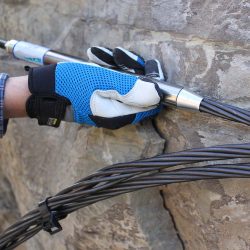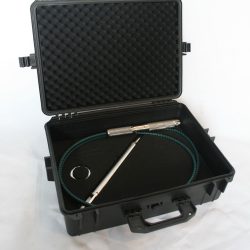Description
Bolt Strain Gauge
Geosystems offer the digi-Bolt strain gauge with 2 to 6 epoxy resin encapsulated strain gauges, in two diametrically opposed slotted channels, which are designed to withstand the traumas of installation.
Each digi-Bolt strain gauge is subjected to a multipoint calibration. The coefficients are written into a microcontroller memory, and a precise linear function is used to enhance linearity, the output signal, and applied strain.
digi-Bolt features:
- Instrumented rebar can be spun in resin
- Readout head encapsulated in a stainless steel tube for
protection. - The microcontroller provides output directly in strain.
- Each bolt is individually
calibrated. - High survivability to shock and vibration.
- Easy to install and maintain
- Low-cost peripheral devices for data-logging (digi_LOGGER) and data upload using TCP/IP (GATEWAY)
- Competitively priced – contact Geosystems for a quotation.
The technology can be applied to rebar, threaded bolts, and various other steel elements used in mining and civil construction/engineering.
Utilising inductive strain gauge technology the digi-Bolt provides data that allows engineers to improve designs, installation quality controls, and long-term operational assessment of projects.
How does it work?
The digi-Bolt is based on a miniature long base length inductive strain gauge, small enough to be recessed into a 3.2mm groove in the bolt.
What is an inductive strain gauge?
A miniature inductive displacement sensor comprising a precision coil and a high permeability core attached to a stainless steel rod. The ends of the displacement sensor are secured to the bolt at a specified distance apart referred to as the base length (BL). This base length may vary between 300mm and 2000mm so comprising a long baselength strain gauge. Upon loading, stretch of the bolt causes displacement of the precision coil relative to
its high permeability core. The corresponding change in coil inductance causes a variation in the frequency of a resonant electrical circuit which is measured by the microcontroller in the instrument head. The accuracy of the displacement sensor is enhanced by an empirically derived temperature compensation algorithm that is applied by the microcontroller.
Individual Calibration
Every instrument is subjected to a multipoint calibration. The calibration coefficients are written into microcontroller memory, and a piecewise linear function is used to enhance linearity the output signal and applied strain. Every instrument is provided with a calibration report.
DATASHEET FOR DIGI-BOLT STRAIN GAUGE
Follow Geosystems on LinkedIn to stay up to date with the latest news and equipment developments.




